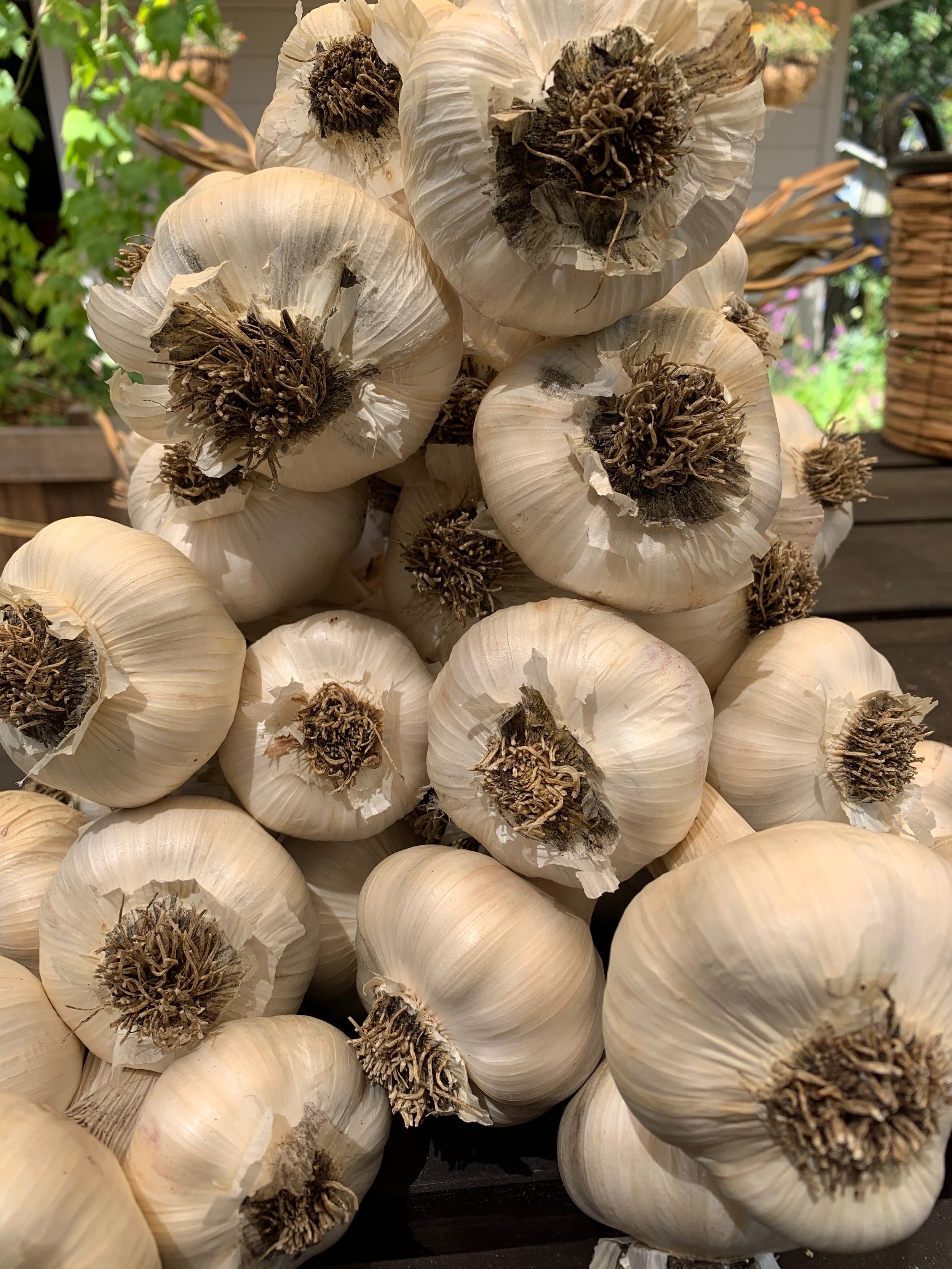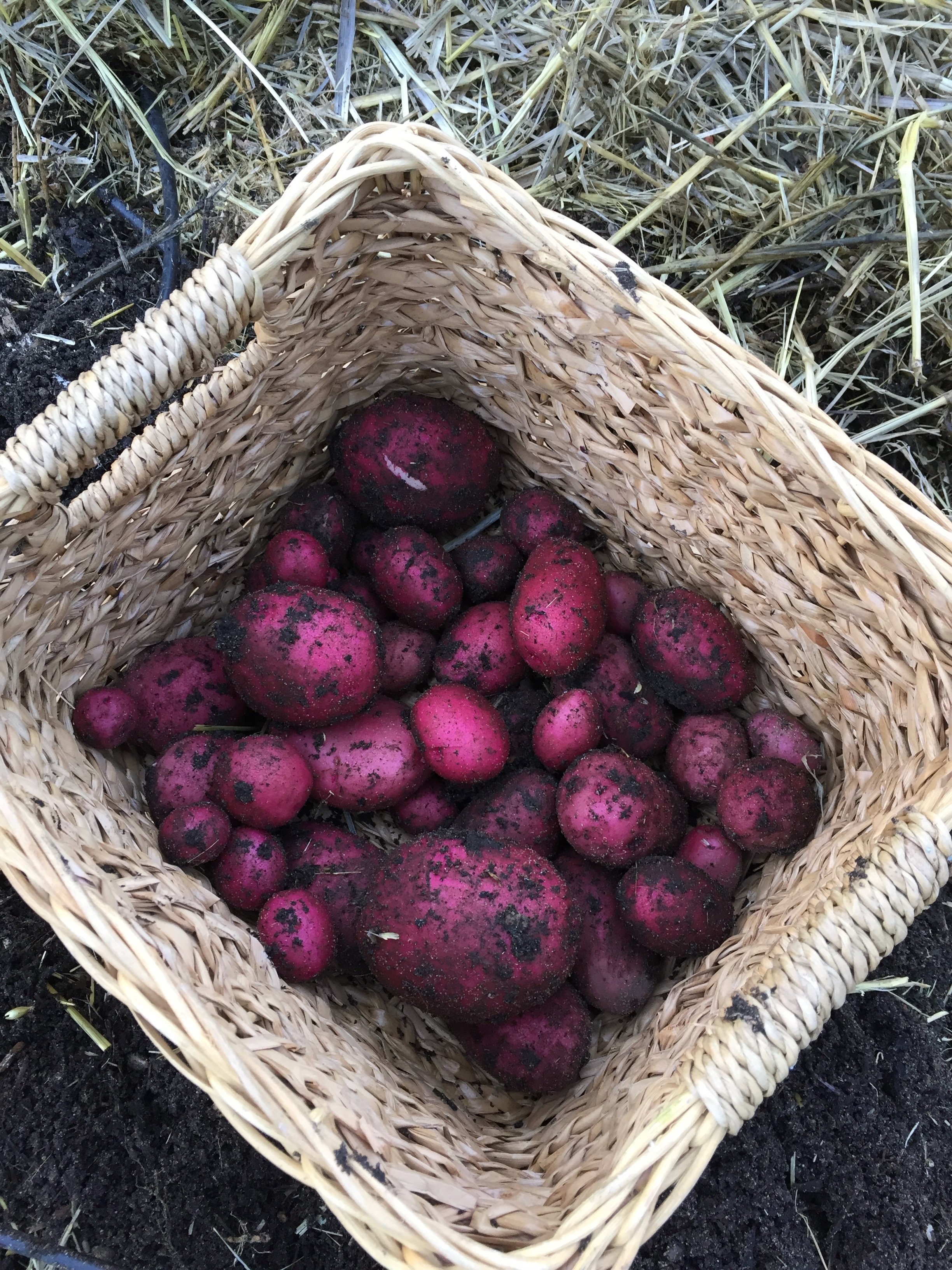Gosh, it's been a fun weekend. The highlight was spending an afternoon with a very good friend, and we had a lively exchange of garden ideas, garden gifts, and love. On top of that we had an impromptu invitation for dinner at a neighbor's house last night - more exchanges of gardening tips and delicious produce! I tasted my first prickly pear fruit (delicious, but lots of seeds!) grown in their garden, and ate some amazing grilled fresh catfish they had caught in Oregon the week before. We brought an heirloom tomato salad with Tom's good Farmer Cheese and basil from the garden on top. Plus some of Tom's garlic dill pickles. Kate made cookies to share, the kids all made a huge bonfire, it was just a great time! A perfect official end to summer vacation, as we get back into the school and work routine this week.
I also had a lot of time to spend in the garden and kitchen, and I got a lot done (I'm headed out again after this post, in fact - potatoes to harvest for dinner!). Mainly just chores, but still, it's such a pleasure to spend time outdoors, then come in for a glass of hibiscus iced tea and make something interesting in the kitchen, then back outdoors for more sunshine and sweat.
Here's the roundup:
Bees and other bugs:
Tom and I opened the hive and there continues to be NO EVIDENCE of wax moths - looks like we caught them just in time. Hallelujah! The ants are also staying away, and the bees are making a LOT of honey. We saw very little pollen, a small amount of brood (consistent with the fact that winter is coming), and a ton of nectar and capped honey. The bees are definitely preparing for cold weather stores. I see them all over my flowers, and I am patting myself on the back that there is plenty of forage for them right now, my early planning is paying off.
In the spirit of continuing that trend, I just scattered many more packets of seed everywhere, mixed in with good compost - more sunflowers, zinnias, cosmos, and lots of herbs - oregano, thyme, sage, marjoram. I hope to continue blossoms all the way through October.
I watched a tiger swallowtail butterfly feeding on some salvia, two cabbage white butterflies (nuisances, but cute ones) chasing each other through the watermelon patch, and scads of monarchs and Gulf Fritillaries feeding on the tithonia. The bees are over everything, especially a very interesting salvia I planted last spring. I can't remember what it's called, darn it.
 |
| cosmos |
 |
| cosmos |
 |
| guara |
 |
| Agastache sunset |
 |
| No idea what this is but I like it! |
 |
| a bee working in salvia |
 |
an old-fashioned rose, left over from the previous owners.
I don't keep many roses as the deer just eat them, but this
one seems to stay safe, somehow |
 |
| bees working in the chive blossoms |
 |
| California fuchsia next to a tiny zinnia |
 |
| nasturtium |
 |
| an interesting seed pod, I can't remember what this is |
 |
| another interesting seed pod, this is from Nigella (Love in a Mist) |
 |
| another cosmos, the varieties are endless |
 |
| more beautiful cosmos |
 |
| some sort of native milkweed, I think, from our watershed |
 |
| native California columbine |
 |
| California asters |
 |
| bees working in the native CA gum plant. The buds are very interesting, too |
 |
| This is that salvia that the bees are going crazy for |
 |
| Something about to bloom! Don't remember what it is, but I'm still excited! |
Chickens:
We're continuing to get five beautiful eggs every day, and the chooks are in good health. Now that I've fed them the last of the collards and romaine from the garden, I'm trying hard to find other sources of greens for them. Sometimes I'll pick the pole bean leaves for them, they love those. Lately I've been chopping down huge swathes of borage and taking it in to them, and they fiddle with that all day. I just planted some special grass in pots that both cats and birds can eat; as soon as it grows, I'll put a pot in there for them to enjoy, and then switch it out as it gets mowed down. I also give them any tomato that has blossom end rot, cucumbers that have gotten too big and bitter for us, and assorted nasturtium leaves, along with scratch, sunflower seeds, and stale yogurt or milk from the fridge.
 |
| That one on the top right is bigger than normal. ouch. |
Cooking:
I tried two new experiments in the kitchen this weekend. The first was a roasted tomato sauce for the freezer. I mixed together about four cups of chopped tomatoes (all kinds), five chopped shallots, five cloves of chopped garlic, a few tablespoons of olive oil, salt and pepper, and a handful of chopped basil. I put it all on a cookie sheet, and put it in the oven for two hours at 300 degrees, stirring it once after an hour. It made the most delicious smell in the house, and all of that reduced down to about a pint for the freezer. Not a huge yield, but what's nice about this is I can make a pint or so every weekend with what's available, and soon we'll have a nice hoard of roasted tomato sauce in the freezer.
 |
| both paste and slicers |
 |
| basil, garlic, and shallot from the garden |


I also decided to try to make fermented whole pickles, like the kind you get at real deli counters. This is also a recipe I can make with whatever is on hand, and add more cucumbers as I harvest them. It works best for smaller fresh pickles, apparently, and if I wait until I have a ton of cucumbers, half of them are too big and bitter, so this recipe appeals to me. I made a brine of 6 tablespoons kosher (or pickling) salt to one quart of water and heated it till the salt dissolved. Meanwhile I added, to a large mason jar, one grape leaf from our neighbor's grapevines, two bay leaves, two smashed garlic cloves, a 1/4 teaspoon of pickle crisp, 2 heaping teaspoons of dill, and 2 teaspoons of other pickling spices (allspice, coriander, mustard seed, etc). If I had any fresh dill left in the garden, I would have added that too. Then I washed the cucumbers and cut a thin slice off the blossom end (apparently you don't want the blossom part in the brine, it makes it taste funky). I put the pickles in with the spices and poured the hot brine over them. I weighted it down with another half-pint mason jar, then put the lid on. You are supposed to let it sit out for two weeks, at least, at room temperature (between 70-80 degrees). The brine will get cloudy. You can add an airlock, like with beer or sauerkraut, or you can 'burp' the pickles about once a week until they are the way you want 'em. You can let them sit up to six weeks on your counter if you want maximum fermentation, or you can put them in your fridge after two. I guess tasting will tell us when they are just right. They'll then keep in the fridge for six months. I'll add more cucumbers, maybe two more, as they ripen.



I also mixed up a new batch of Thieves Vinegar. I do this every two weeks. I pick lavender or mint from the garden, stuff it into a mason jar, and cover the whole thing with apple cider vinegar. I let it sit out in the sun, lidded, for two weeks. Then I decant into another clean jar and use it in the laundry room as a natural fabric softener. We love the spicy smell, and we like that it doesn't have any chemicals.
Produce from the garden:
We're harvesting tomatoes (all kinds), both sweet and hot peppers, green beans,
delicata squash, watermelons, cucumbers, basil, and potatoes. We're a hairsbreadth away from butternut squash and cantaloupe. We're a little further out from pumpkins and sweet potatoes. The buckwheat cover crop is doing well, and we've had some new growth (surprisingly!) in many areas - the asparagus patch (a spring crop, for heaven's sake), the alpine strawberry patch, and the apple tree seems to be putting out another crop for us! That summer pruning must have made the apple tree feel extremely refreshed. We aren't complaining!
 |
| watermelon blossom |
 |
| Bloody Butcher tomatoes |
 |
| Alpine strawberry blossom |
 |
| pumpkin blossom |
 |
| Jimmy Nardello sweet peppers |
 |
| Panache fig |
 |
| buckwheat cover crop |
 |
| asparagus patch |
 |
| apple blossom |
 |
| second crop of apples |
Jobs looming on the horizon:
As crops put out their last fruits, I'll pull them, and put in a quick cover crop of buckwheat. After a month of the cover crop, I'll turn it in and let it rot, then cover each bed with a layer of compost from the chicken coop (heavy mulch made up of hay, sawdust, lots and lots of manure, and whatever vegetable or fruit bits didn't get eaten). Around the first of November, I'll start moving aside that mulch and plant our winter crops in. We'll need to make hoop tunnels for the North Garden and make sure the ones in the South Garden are secure, and order new floating row cover. I'll need to order garlic and shallot starts soon, as well as winter seed (kale, spinach, chard, cauliflower, broccoli, kohlrabi, turnips, more romaine, braising greens, possibly even red winter wheat). We'll need to watch the beehive vigilantly as varroa mite season is coming up, and we don't want a repeat of last year. There's still a lot of preserving in our near future as we continue to can and freeze the harvest - we've got the two hottest months of summer coming up in September and October, here! I need to sheet mulch the little bit of grass we have left and decide what the heck to do with that area - a huge herb garden, with paths winding around so you brush against the plants and smell them? Or a native California meadow, with summer-dormant grasses and lots of spring bulbs? What do you think? I'd like to sheet mulch it in the next month, and plant it once there is a hope of winter rain.
I hope, wherever you are, you are enjoying some time outside and enjoying nature!


















































